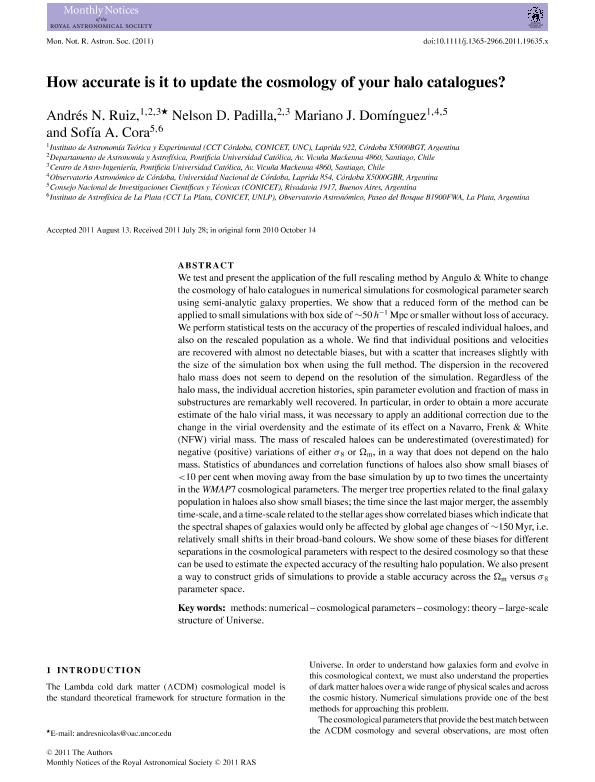Artículo
How accurate is it to update the cosmology of your halo catalogues?
Ruiz, Andrés Nicolás ; Padilla, Nelson David
; Padilla, Nelson David ; Dominguez Romero, Mariano Javier de Leon
; Dominguez Romero, Mariano Javier de Leon ; Cora, Sofia Alejandra
; Cora, Sofia Alejandra
 ; Padilla, Nelson David
; Padilla, Nelson David ; Dominguez Romero, Mariano Javier de Leon
; Dominguez Romero, Mariano Javier de Leon ; Cora, Sofia Alejandra
; Cora, Sofia Alejandra
Fecha de publicación:
12/2011
Editorial:
Wiley Blackwell Publishing, Inc
Revista:
Monthly Notices of the Royal Astronomical Society
ISSN:
0035-8711
e-ISSN:
1365-2966
Idioma:
Inglés
Tipo de recurso:
Artículo publicado
Clasificación temática:
Resumen
We test and present the application of the full rescaling method by Angulo & White to change the cosmology of halo catalogues in numerical simulations for cosmological parameter search using semi-analytic galaxy properties. We show that a reduced form of the method can be applied to small simulations with box side of ~50h-1Mpc or smaller without loss of accuracy. We perform statistical tests on the accuracy of the properties of rescaled individual haloes, and also on the rescaled population as a whole. We find that individual positions and velocities are recovered with almost no detectable biases, but with a scatter that increases slightly with the size of the simulation box when using the full method. The dispersion in the recovered halo mass does not seem to depend on the resolution of the simulation. Regardless of the halo mass, the individual accretion histories, spin parameter evolution and fraction of mass in substructures are remarkably well recovered. In particular, in order to obtain a more accurate estimate of the halo virial mass, it was necessary to apply an additional correction due to the change in the virial overdensity and the estimate of its effect on a Navarro, Frenk & White (NFW) virial mass. The mass of rescaled haloes can be underestimated (overestimated) for negative (positive) variations of either σ8 or in a way that does not depend on the halo mass. Statistics of abundances and correlation functions of haloes also show small biases of <10 per cent when moving away from the base simulation by up to two times the uncertainty in the WMAP7 cosmological parameters. The merger tree properties related to the final galaxy population in haloes also show small biases; the time since the last major merger, the assembly time-scale, and a time-scale related to the stellar ages show correlated biases which indicate that the spectral shapes of galaxies would only be affected by global age changes of ~150Myr, i.e. relatively small shifts in their broad-band colours. We show some of these biases for different separations in the cosmological parameters with respect to the desired cosmology so that these can be used to estimate the expected accuracy of the resulting halo population. We also present a way to construct grids of simulations to provide a stable accuracy across the versus σ8 parameter space.
Archivos asociados
Licencia
Identificadores
Colecciones
Articulos(IALP)
Articulos de INST.DE ASTROFISICA LA PLATA
Articulos de INST.DE ASTROFISICA LA PLATA
Articulos(IATE)
Articulos de INST.DE ASTRONOMIA TEORICA Y EXPERIMENTAL
Articulos de INST.DE ASTRONOMIA TEORICA Y EXPERIMENTAL
Citación
Ruiz, Andrés Nicolás; Padilla, Nelson David; Dominguez Romero, Mariano Javier de Leon; Cora, Sofia Alejandra; How accurate is it to update the cosmology of your halo catalogues?; Wiley Blackwell Publishing, Inc; Monthly Notices of the Royal Astronomical Society; 418; 4; 12-2011; 2422-2434
Compartir
Altmétricas



